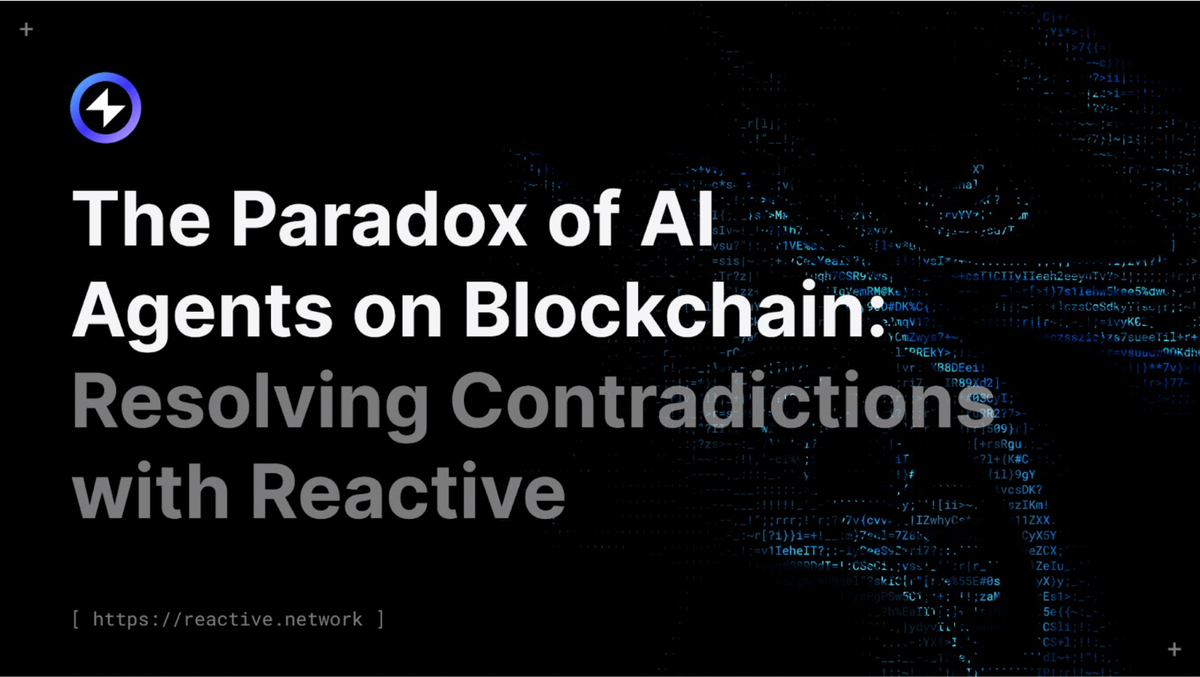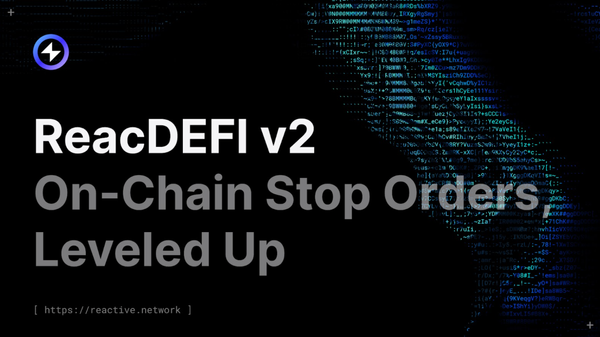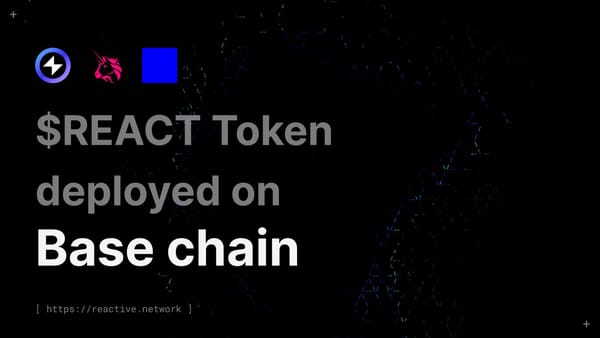The Paradox of AI Agents on Blockchain: Resolving Contradictions with Reactive

The intersection of artificial intelligence and blockchain is promising, but technically fraught. AI agents are autonomous systems designed to learn, reason, and adapt. Blockchains, by contrast, prioritize determinism, transparency, and immutability.
This contrast presents deep design tensions. AI thrives on probabilistic reasoning and flexible execution. Blockchains demand finality and verifiability. When these paradigms collide, especially in decentralized environments where AI agents may be granted control over assets, serious architectural and security issues emerge.
This article explores the key technical contradictions between AI and blockchain, and introduces a practical design pattern offered by Reactive. By splitting decision-making from execution and adopting an event-driven architecture, Reactive Network provides a framework for safe, autonomous AI integration without compromising the integrity of decentralized systems.
Architectural Incompatibilities
Static Infrastructure v Adaptive Intelligence
Smart contracts are immutable once deployed, a feature designed to ensure auditability and predictability. AI systems, by contrast, evolve over time: learning from data, adjusting strategies, and updating models. Attempting to embed dynamic AI logic into static contract environments introduces fundamental friction. Even when models are kept off-chain, the inability to update state or behavior on-chain limits integration.
This tension extends to storage: AI models often require large parameter sets and histories, while blockchains impose strict limits on memory and state changes. Persisting AI-relevant data on-chain is rarely practical.
Deterministic Execution v Probabilistic Reasoning
Blockchains depend on determinism, every node must produce the same result from the same input to maintain consensus. Yet most AI systems, particularly those using neural networks or stochastic optimizers, are inherently non-deterministic. Their reliance on randomness or confidence thresholds is incompatible with the guarantees required by consensus protocols.
As a result, meaningful AI inference can’t safely happen on-chain without undermining reliability or consensus integrity.
Transparent State v Opaque Logic
Blockchain systems are built around transparency: users can inspect state transitions, read contract logic, and verify every computation. In contrast, many AI models, especially those built on deep learning, operate as black boxes. Their internal decision-making processes are difficult to interpret, which complicates accountability and trust in regulated or mission-critical environments.
This creates a transparency gap: blockchain demands explainability, while AI often resists it.
The Risk of Key Custody by AI Agents
Autonomous Control Without Accountability
Assigning private keys to AI agents gives them direct control over assets. While this enables automation, it removes meaningful oversight. An agent can initiate transactions, transfer funds, or interact with contracts, all without human review. There are no built-in safeguards to prevent mistakes, exploits, or behaviors that violate compliance standards.
This creates a trust vacuum: the agent becomes the sole authority, with no way to intervene or attribute responsibility when things go wrong.
Expanded Attack Surface and Operational Fragility
Embedding private keys inside AI runtimes, especially those deployed in cloud or edge environments, increases exposure to attack. A compromised model or container becomes a compromised wallet. These agents also introduce operational fragility: model bugs, system errors, or unexpected behavior can trigger irreversible actions.
Even strong agents can be undermined by poor environment hygiene or weak interfaces. Key custody makes every deployment a critical infrastructure component whether it was meant to be or not.
Misalignment, Compliance Gaps, and Architectural Limitations
AI agents often optimize for local objectives like speed, cost, or throughput. But these goals may conflict with broader system requirements like capital preservation, regulatory compliance, or user intent. Without well-defined boundaries, agents may behave “correctly” from their perspective while violating critical constraints.
While several techniques have been explored to mitigate the risks of key custody, each comes with trade-offs:
- Multisignature wallets can add layers of control but introduce latency and hinder autonomous execution.
- Trusted Execution Environments (TEEs) offer hardware-level isolation but rely on opaque vendor implementations and have been subject to critical vulnerabilities in practice.
- Multi-Party Computation (MPC) distributes trust across participants, which improves security, but at the cost of significant coordination overhead and computational complexity.
- SNARK-based pre-approval mechanisms allow proving that a transaction meets certain conditions before it's signed. While conceptually elegant, they’re not yet efficient or expressive enough to handle rich AI-driven logic or large-scale inference tasks.
In short, these approaches are useful in specific contexts, but none provide a comprehensive solution for securing AI agents with direct transaction authority. The deeper issue is architectural, not just cryptographic.
Reactive Approach
From Transactions to Signals
In traditional blockchain systems, agents (whether human or automated) directly sign and broadcast transactions to initiate state changes. This creates a tight coupling between the decision-maker and the execution layer, a design that becomes problematic when the agent is an AI system.
Reactive takes a different approach. Instead of executing transactions directly, AI agents emit signals, proposals, or event triggers. Reactive contracts observe these inputs and execute predefined logic only when conditions are met. This architecture shifts control to a programmable layer that can enforce rules, constraints, and safeguards while still responding dynamically to AI-produced inputs.
Reactive Contracts and ReactVM
At the core of Reactive Network is a virtual machine optimized for event-driven logic. Rather than following a call-response execution model, Reactive Contracts are triggered by events, whether on-chain state changes or external messages.
This model is a natural fit for AI integration. While full machine learning inference is still impractical on-chain, ReactVM supports conditional branches, thresholds, and triggers, enabling automation that feels intelligent while remaining fully deterministic and auditable. It also improves gas efficiency by avoiding redundant execution paths and focusing on reactive flows.
Secure Cross-Chain Execution
Reactive Network is designed with native support for cross-chain messaging protocols (e.g., GMP), allowing contracts to coordinate across different chains without requiring agents to manage bridging or private keys.
Just as importantly, AI agents in this model never hold signing authority. They submit proposals or emit events; Reactive handles execution. This eliminates the need to embed keys within runtime environments and significantly reduces the attack surface.
To maintain safety, reactive contracts can enforce:
- Budget caps
- Role-based permissions
- Time-based constraints
- Whitelisted operations
These built-in controls ensure that agents can act semi-autonomously within defined bounds, without compromising system integrity.
What Becomes Possible
This architecture unlocks a safer class of AI-enabled on-chain systems:
- Autonomous trading or rebalancing strategies that publish triggers instead of signing trades
- Cross-chain liquidity routing guided by off-chain AI forecasts
- AI agents serving multiple users with isolated execution per account
- On-chain policy frameworks constraining how agents interact with protocols
- Composable AI automation across DeFi, DAOs, NFTs, and governance mechanisms
Rather than forcing AI onto the chain, Reactive builds the infrastructure for AI to interact with blockchain in a verifiable, auditable, and modular way.
Recap: A Hybrid Future
Fully autonomous AI agents managing capital on-chain remain a future ambition, but the path forward is clear. In the short term, the hybrid approach dominates:
- Off-chain: AI systems perform compute-intensive learning, forecasting, and optimization
- On-chain: Reactive contracts validate, enforce, and execute within strict constraints
This balance provides the best of both worlds: scalable, efficient intelligence off-chain paired with deterministic, secure, and auditable execution on-chain.
Looking ahead, we may see AI enabling real-time adaptive DeFi protocols, autonomous governance optimizing DAO treasury strategies, and cross-chain liquidity managers balancing capital dynamically. Achieving this vision depends on continued progress in areas such as:
- Verifiable AI decisions via zero-knowledge proofs
- Frameworks for safe AI design and goal alignment
- Standards for composable identity and intent signaling
Reactive provides the infrastructure needed to connect AI and blockchain without merging their assumptions. Rather than running AI on-chain, it allows smart contracts to respond to AI outputs in a predictable way. AI and blockchain are built on different principles, adaptability v determinism. Instead of forcing them to fit, we can design systems that let each do what it does best.
By separating decision-making from execution, and using reactive contracts instead of direct control, AI agents can participate in decentralized systems without compromising safety or transparency.
We don’t need to put machine learning on-chain. We need infrastructure that allows AI to transparently influence what happens there.





